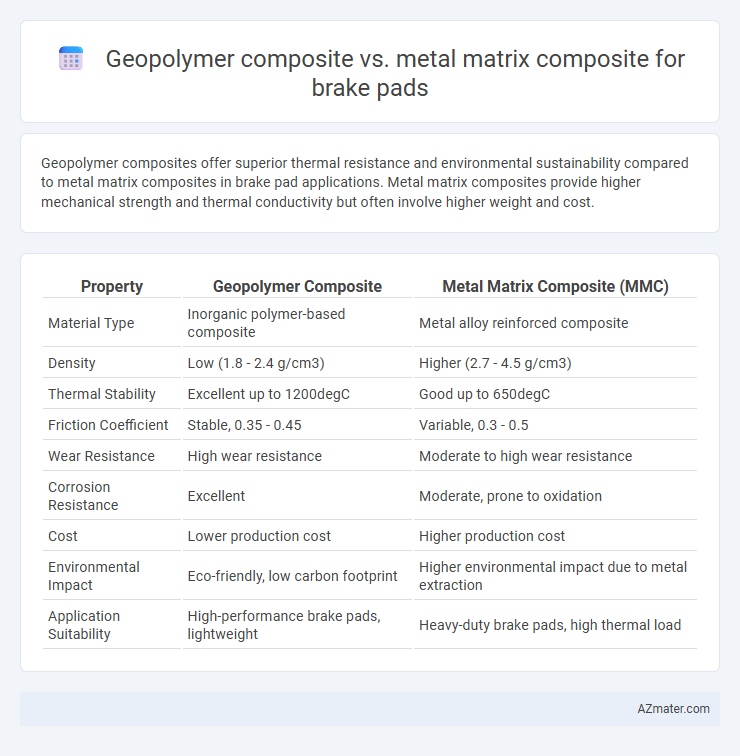Geopolymer composites offer superior thermal resistance and environmental sustainability compared to metal matrix composites in brake pad applications. Metal matrix composites provide higher mechanical strength and thermal conductivity but often involve higher weight and cost.
Table of Comparison
| Property | Geopolymer Composite | Metal Matrix Composite (MMC) |
|---|---|---|
| Material Type | Inorganic polymer-based composite | Metal alloy reinforced composite |
| Density | Low (1.8 - 2.4 g/cm3) | Higher (2.7 - 4.5 g/cm3) |
| Thermal Stability | Excellent up to 1200degC | Good up to 650degC |
| Friction Coefficient | Stable, 0.35 - 0.45 | Variable, 0.3 - 0.5 |
| Wear Resistance | High wear resistance | Moderate to high wear resistance |
| Corrosion Resistance | Excellent | Moderate, prone to oxidation |
| Cost | Lower production cost | Higher production cost |
| Environmental Impact | Eco-friendly, low carbon footprint | Higher environmental impact due to metal extraction |
| Application Suitability | High-performance brake pads, lightweight | Heavy-duty brake pads, high thermal load |
Introduction to Brake Pad Materials
Brake pad materials are critical for vehicle safety and performance, with Geopolymer composites offering eco-friendly, high-temperature resistance and excellent wear properties due to their inorganic polymer matrix. Metal matrix composites (MMCs) provide superior strength, thermal conductivity, and durability by embedding metal alloys with reinforcing particles, suitable for high-stress braking applications. The choice between Geopolymer composites and MMCs depends on balancing environmental impact, thermal performance, and mechanical demands in brake system design.
Overview of Geopolymer Composites
Geopolymer composites are inorganic materials formed by the reaction of aluminosilicate powders with alkaline solutions, offering excellent thermal stability and resistance to high temperatures, making them suitable for brake pad applications. These composites exhibit superior wear resistance, lower environmental impact, and reduced cost compared to traditional metal matrix composites, which often suffer from higher density and corrosion issues. Their inherent fire retardancy and lightweight properties contribute to enhanced braking performance and longevity in automotive and industrial brake systems.
Overview of Metal Matrix Composites
Metal matrix composites (MMCs) for brake pads combine metal alloys such as aluminum or magnesium with reinforcing materials like ceramics or carbon fibers to enhance strength, thermal conductivity, and wear resistance. MMCs offer superior performance in high-temperature environments and improved mechanical properties compared to traditional metals, making them ideal for automotive and aerospace braking systems. Their ability to reduce weight while maintaining durability results in better fuel efficiency and extended lifespan of brake components.
Material Properties Comparison
Geopolymer composites exhibit superior thermal stability and corrosion resistance compared to metal matrix composites (MMCs), making them ideal for high-temperature brake pad applications. MMCs offer enhanced mechanical strength and wear resistance due to their metal reinforcement but generally suffer from higher weight and susceptibility to thermal expansion. The low density and eco-friendly nature of geopolymer composites contribute to improved braking performance and reduced environmental impact, whereas MMCs deliver better conductivity and structural rigidity.
Thermal Stability and Heat Resistance
Geopolymer composites exhibit superior thermal stability and heat resistance compared to metal matrix composites, maintaining structural integrity at temperatures above 1000degC, which is critical for high-performance brake pads. Metal matrix composites typically withstand temperatures up to 600-700degC but often suffer from thermal expansion mismatch and oxidation, reducing brake pad durability under extreme heat. The inherent ceramic nature of geopolymer composites ensures minimal thermal degradation and enhanced performance in high-friction, high-temperature braking environments.
Wear Resistance and Durability
Geopolymer composites exhibit excellent wear resistance in brake pad applications due to their inherent ceramic-like hardness and superior thermal stability, which prevents degradation under high friction conditions. Metal matrix composites provide enhanced durability through their robust metal bonding and capacity to absorb and dissipate heat, reducing brake fade and extending service life. Comparative studies reveal that geopolymer composites offer longer wear life in abrasive environments, while metal matrix composites excel in impact resistance and mechanical strength during dynamic braking.
Environmental Impact and Sustainability
Geopolymer composites in brake pads offer significant environmental advantages by utilizing industrial byproducts such as fly ash and reducing carbon emissions during production compared to traditional metal matrix composites (MMC). The lightweight nature of geopolymers also enhances fuel efficiency and reduces wear particulate matter, contributing to lower environmental pollution. While MMCs provide superior thermal conductivity and mechanical strength, their extraction and processing incur higher energy consumption and waste generation, making geopolymers a more sustainable choice for eco-friendly brake pad applications.
Cost Effectiveness and Manufacturing
Geopolymer composites for brake pads offer significant cost effectiveness due to lower raw material expenses and energy-efficient manufacturing processes compared to metal matrix composites (MMCs). The production of geopolymer composites involves simpler synthesis using abundant industrial by-products like fly ash, reducing overall manufacturing costs and environmental impact. MMCs require complex alloying and high-temperature processing, increasing material costs and fabrication time, which limits their cost efficiency in large-scale brake pad production.
Performance in Real-World Applications
Geopolymer composites in brake pads offer superior thermal stability and corrosion resistance, leading to longer lifespan under high-temperature braking conditions compared to metal matrix composites (MMCs). MMCs provide enhanced mechanical strength and wear resistance, which translates to improved durability in high-stress, heavy-duty braking scenarios. Real-world performance evaluations reveal that geopolymer composites excel in environments prone to thermal degradation, while MMCs are preferred for applications demanding higher load-bearing capacity and consistent frictional properties.
Future Trends in Brake Pad Technology
Geopolymer composites present a sustainable alternative to metal matrix composites for brake pads due to their superior thermal stability, lightweight properties, and reduced environmental impact. Future trends indicate a shift towards incorporating nanomaterials and hybrid fibers within geopolymer matrices to enhance wear resistance and friction performance under extreme conditions. Innovations in additive manufacturing techniques are also expected to enable customized, high-performance brake pads combining the advantages of both geopolymer and metal matrix composites.

Infographic: Geopolymer composite vs Metal matrix composite for Brake pad
 azmater.com
azmater.com